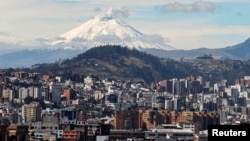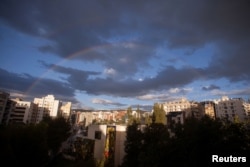In a city menaced by the threat of volcanic eruptions, earthquakes and floods, protecting thousands of families living in Quito's low-income neighborhoods from disasters is an urgent task, said a senior official for the Andean city.
“People settle in high-risk areas where you cannot mitigate those risks. It's a trend that we need to turn around,” David Jácome Polit, Quito's chief resilience officer, told the Thomson Reuters Foundation in an interview.
The problem will be addressed in a strategy to bolster the resilience of Quito — one of the world's highest capital cities and home to around 2.6 million people in its metropolitan area — which is due to be released by the end of the year, he added.
“What is really affecting us right now is the poor handling of our territory, the informal growth, the urban sprawl which makes this city highly vulnerable,”
Jácome said by telephone from Quito, which is part of the 100 Resilient Cities initiative, backed by the Rockefeller Foundation.
Marginalized areas of the city — boxed in by mountains and built on the slopes of the active Pichincha volcano — should also benefit from the opening of the first metro line in two years' time, he said.
Alongside transport, the new urban resilience strategy will prioritize the issue of informal and often illegal settlements.
It will also promote environmentally sustainable businesses, boost youth employment and promote wider social involvement in decisions on how to develop the city, said Jácome.
With private cars making up 70 percent of traffic but only 30 percent of trips each day, the planned 22-km (14-mile) metro line should substantially ease worsening congestion, as it becomes integrated with the bus network, he added.
For people living outside the busy center of Quito, which hosted last year's U.N. summit on the future of the world's cities, the metro could help create job opportunities and lead to investment in better housing around the 15 planned stations.
“We see the first metro line as an opportunity to build resilience, to make the city efficient, to make it inclusive, to start creating prosperity from these concentration points — the metro stops," he said.
Risky slopes
The new strategy will also strive to reduce the risk of natural disasters for city residents, said Jácome.
Preventing the construction of new developments in precarious locations such as the city's slopes must be a priority, alongside improving existing housing, he said.
But he admitted there is little in the way of funding to relocate people from vulnerable areas of Quito, whose colonial center is a UNESCO world heritage site.
“It's not only that they are settled where they shouldn't be settled, but the construction quality is very low. It's not earthquake-resistant at all,” he said.
The use of concrete roofs and blocks, for example, increase the risk for people during tremors.
Last year's 7.8-magnitude earthquake — the strongest in Ecuador since 1979 — devastated parts of the Pacific coast and killed more than 660 people, sorely testing the Andean country and denting its economy.
With a string of volcanoes close to Quito, including the active snow-capped Cotopaxi some 50 km to the south, drawing up the city's resilience strategy has involved mapping districts' vulnerability to eruptions, landslides and flooding, so this can be factored into development plans, said Jácome.
Greener business
Another key sector for resilience efforts is Quito's water supply. The city has benefited from the first of around 60 water funds developed worldwide by U.S.-based group The Nature Conservancy to invest in the protection of watersheds such as the high-altitude plains around Quito, located just a few miles south of the equator.
There is a need to focus on the rural areas surrounding the city, which are part of the greater metropolitan area and a biodiversity hotspot, said Jácome. Here, the flora and fauna are threatened by environmentally harmful businesses such as open pit mines and cattle ranching for beef, he added.
“If we provide a different opening for people living off these activities — for example, ecotourism or carbon sequestration markets — that's an opportunity for preserving these lands and providing jobs for the people living there ... in a very sustainable way,” he said.
The city, meanwhile, should involve more of its residents in urban planning, and making policies and decisions, in order to “strengthen the social tissue,” he added.
“That's what's going to make the city resilient in the long term from a social point of view,” he said.









